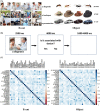Representation of event and object concepts in ventral anterior temporal lobe and angular gyrus
- PMID: 38185997
- PMCID: PMC10839851
- DOI: 10.1093/cercor/bhad519
Representation of event and object concepts in ventral anterior temporal lobe and angular gyrus
Abstract
Semantic knowledge includes understanding of objects and their features and also understanding of the characteristics of events. The hub-and-spoke theory holds that these conceptual representations rely on multiple information sources that are integrated in a central hub in the ventral anterior temporal lobes. The dual-hub theory expands this framework with the claim that the ventral anterior temporal lobe hub is specialized for object representation, while a second hub in angular gyrus is specialized for event representation. To test these ideas, we used representational similarity analysis, univariate and psychophysiological interaction analyses of fMRI data collected while participants processed object and event concepts (e.g. "an apple," "a wedding") presented as images and written words. Representational similarity analysis showed that angular gyrus encoded event concept similarity more than object similarity, although the left angular gyrus also encoded object similarity. Bilateral ventral anterior temporal lobes encoded both object and event concept structure, and left ventral anterior temporal lobe exhibited stronger coding for events. Psychophysiological interaction analysis revealed greater connectivity between left ventral anterior temporal lobe and right pMTG, and between right angular gyrus and bilateral ITG and middle occipital gyrus, for event concepts compared to object concepts. These findings support the specialization of angular gyrus for event semantics, though with some involvement in object coding, but do not support ventral anterior temporal lobe specialization for object concepts.
Keywords: angular gyrus; anterior temporal lobe; event semantics; object semantics; semantic representation.
© The Author(s) 2024. Published by Oxford University Press.
Figures






Similar articles
-
Semantic retrieval during overt picture description: Left anterior temporal or the parietal lobe?Neuropsychologia. 2015 Sep;76:125-35. doi: 10.1016/j.neuropsychologia.2014.12.012. Epub 2014 Dec 11. Neuropsychologia. 2015. PMID: 25497693 Free PMC article.
-
Automatic and Controlled Semantic Retrieval: TMS Reveals Distinct Contributions of Posterior Middle Temporal Gyrus and Angular Gyrus.J Neurosci. 2015 Nov 18;35(46):15230-9. doi: 10.1523/JNEUROSCI.4705-14.2015. J Neurosci. 2015. PMID: 26586812 Free PMC article.
-
FMRI of shared-stream priming of lexical identification by object semantics along the ventral visual processing stream.Neuropsychologia. 2019 Oct;133:107185. doi: 10.1016/j.neuropsychologia.2019.107185. Epub 2019 Sep 9. Neuropsychologia. 2019. PMID: 31513807
-
The neurocognitive basis of knowledge about object identity and events: dissociations reflect opposing effects of semantic coherence and control.Philos Trans R Soc Lond B Biol Sci. 2020 Feb 3;375(1791):20190300. doi: 10.1098/rstb.2019.0300. Epub 2019 Dec 16. Philos Trans R Soc Lond B Biol Sci. 2020. PMID: 31840592 Free PMC article. Review.
-
Semantic and action tool knowledge in the brain: Identifying common and distinct networks.Neuropsychologia. 2021 Aug 20;159:107918. doi: 10.1016/j.neuropsychologia.2021.107918. Epub 2021 Jun 22. Neuropsychologia. 2021. PMID: 34166668 Review.
Cited by
-
Role of the left posterior middle temporal gyrus in shape recognition and its reconstruction during drawing: A study combining transcranial magnetic stimulation and functional near infrared spectroscopy.PLoS One. 2024 May 3;19(5):e0302375. doi: 10.1371/journal.pone.0302375. eCollection 2024. PLoS One. 2024. PMID: 38701103 Free PMC article.
-
Neuroanatomical correlates of language impairment in non-fluent variant of primary progressive aphasia.Front Hum Neurosci. 2024 Dec 4;18:1486809. doi: 10.3389/fnhum.2024.1486809. eCollection 2024. Front Hum Neurosci. 2024. PMID: 39698146 Free PMC article.
References
-
- Acres K, Taylor K, Moss H, Stamatakis E, Tyler LK. Complementary hemispheric asymmetries in object naming and recognition: a voxel-based correlational study. Neuropsychologia. 2009:47(8–9):1836–1843. - PubMed
-
- Altmann G, Ekves Z. Events as intersecting object histories: a new theory of event representation. Psychol Rev. 2019:126(6):817–840. - PubMed
-
- Andersen RA, Cui H. Intention, action planning, and decision making in parietal-frontal circuits. Neuron. 2009:63(5):568–583. - PubMed
-
- Ashburner J. A fast diffeomorphic image registration algorithm. NeuroImage. 2007:38(1):95–113. - PubMed
Publication types
MeSH terms
Grants and funding
LinkOut - more resources
Full Text Sources

